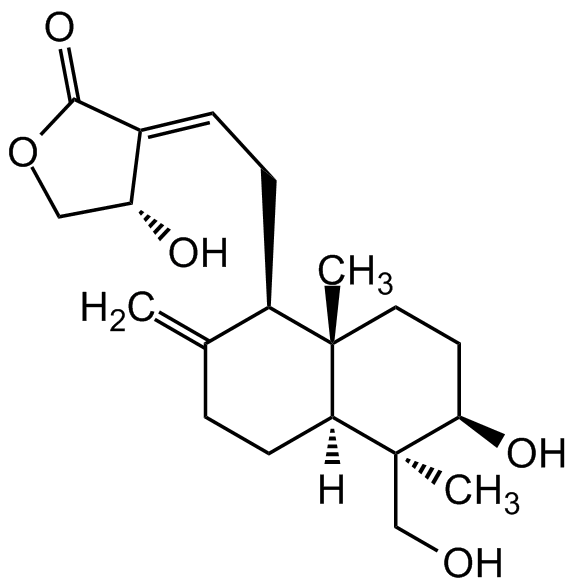Andrographolide
| Code | Size | Price |
|---|
| CDX-A0576-M500 | 500 mg | £108.00 |
Quantity:
Prices exclude any Taxes / VAT
Overview
Host Type: Plant
Regulatory Status: RUO
Shipping:
AMBIENT
Storage:
-20°C
Images
Documents
Further Information
Alternate Names/Synonyms:
Andrographis
Appearance:
White to light yellow powder.
CAS:
5508-58-7
EClass:
32160000
Form (Short):
solid
GHS Symbol:
GHS07
Handling Advice:
Protect from light and moisture.
Hazards:
H315, H319, H335
InChi:
InChI=1S/C20H30O5/c1-12-4-7-16-19(2,9-8-17(23)20(16,3)11-21)14(12)6-5-13-15(22)10-25-18(13)24/h5,14-17,21-23H,1,4,6-11H2,2-3H3/b13-5+/t14-,15-,16+,17-,19+,20+/m1/s1
InChiKey:
BOJKULTULYSRAS-OTESTREVSA-N
Long Description:
Chemical. CAS: 5508-58-7. Formula: C20H30O5. MW: 350.455. Andrographolide, a bioactive diterpene lactone, is the main constituent of Andrographis paniculata, a plant used in traditional medicines. It is known to have different biological properties such as anti-inflammatory, immunosuppressive, antidiabetic, antihyperglycemic, antibacterial, antioxidant, antinoniceptive, antimalarial, anticancer and hepatoprotective activity. It also shows potent anti-viral effect against dengue virus. It blocks T-cell proliferation and the proliferation of several cancer cell lines in vitro. It acts as an irreversible antagonist of NF-kappa and AP-1 (IC50 < 15 µM) activation, and prevents in vitro and in vivo T cell activation.
MDL:
MFCD07778082
Molecular Formula:
C20H30O5
Molecular Weight:
350.455
Package Type:
Vial
Precautions:
P264, P280, P261, P362+364
Product Description:
Andrographolide, a bioactive diterpene lactone, is the main constituent of Andrographis paniculata, a plant used in traditional medicines. It is known to have different biological properties such as anti-inflammatory, immunosuppressive, antidiabetic, antihyperglycemic, antibacterial, antioxidant, antinoniceptive, antimalarial, anticancer and hepatoprotective activity. It also shows potent anti-viral effect against dengue virus. It blocks T-cell proliferation and the proliferation of several cancer cell lines in vitro. It acts as an irreversible antagonist of NF-kappa and AP-1 (IC50 < 15 µM) activation, and prevents in vitro and in vivo T cell activation.
Purity:
>98% (HPLC)
Signal Word:
Warning
SMILES:
C=C1CC[C@@]([C@@](CO)(C)[C@H](O)CC2)([H])[C@]2(C)[C@@H]1C/C=C3C(OC[C@H]/3O)=O
Solubility Chemicals:
Soluble in chloroform, DMF (15mg/ml) or DMSO (2mg/ml).
Source / Host:
Plant
Transportation:
Non-hazardous
UNSPSC Category:
Natural Products/Extracts
UNSPSC Number:
12352200
Use & Stability:
Stable for at least 2 years after receipt when stored at -20°C.
References
(1) P.K. Visen, et al.; J. Ethnopharmacol. 40, 131 (1993) | (2) W.F. Chiou, et al.; Br. J. Pharmacol. 129, 1553 (2000) | (3) B.C. Yu, et al.; Planta Med. 69, 1075 (2003) | (4) Y.F. Xia, et al.; J. Immunol. 173, 4207 (2004) | (5) J.H. Chen, et al.; Biochem. Pharmacol. 67, 1337 (2004) | (6) R.A. Burgos, et al.; Planta Med. 71, 429 (2005) | (7) M.I. Iruretagoyena, et al.; J. Pharmacol. Exp. Ther. 312, 366 (2005) | (8) C. Liu, et al.; Genes Cancer 2, 151 (2011) | (9) J.C. Lim, et al.; Clin. Exp. Pharmacol. Physiol. 39, 300 (2012) (Review) | (10) S.K. Mishra, et al.; Front. Biosci. 7, 255 (2015) (Review) | (11) V. Kishore, et al.; Curr. Top. Med. Chem. 17, 845 (2017) (Review) | (12) S. Gupta, et al.; Arch. Virol. 162, 611 (2017) (Review) | (13) W.S.D. Tan, et al.; Biochem. Pharmacol. 139, 71 (2017) (Review) | (14) C.H. Yang, et al.; Int. J. Mol. Sci. 18, E1638 (2017) (Review) | (15) M.T. Islam; Front. Pharmacol. 8, 571 (2017) (Review) | (16) J. Lu, et al.; Biomed. Pharmacother. 117, 109078 (2019) (Review) | (17) L. Zhang, et al.; Pharmacology (Epub ahead of print) (2019) (Review) | (18) E. Mussard, et al.; Antioxidants 8, E571 (2019) (Review)



